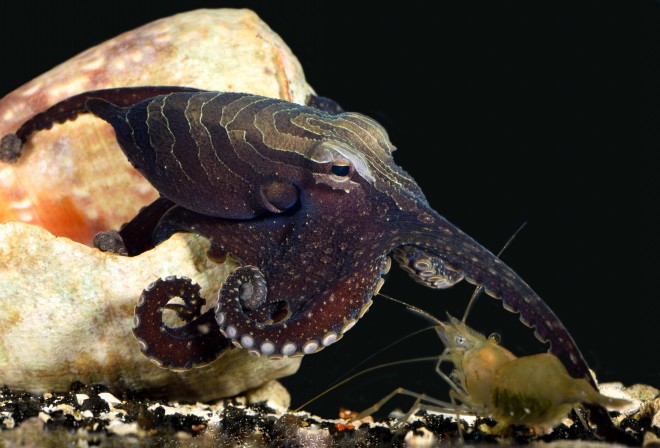
This handout photo provided by Roy L. Caldwell shows a LPSO male A15 canteleve large Pacific striped octopus about to catch a shrimp. AP
Scientists are learning more about a mysterious octopus which taps its prey before stunning the unwitting victim into its arms, according to a study Wednesday.
A preference for rough sex and for traveling in groups has also been noticed in the larger Pacific striped octopus, according to the research published in the journal PLOS ONE.
The animal was first discovered in Central America in the 1970s, but was so unusual scientists did not know what to make of it.
But further studies in captivity have revealed a wider picture of its behavior for the first time.
Not only does it have a stealthy way of sneaking up on a shrimp, extending one arm to poke it, and then seizing the surprised animal in its remaining arms, it is also far more gregarious than others of the 300 known octopus species, most of which are solitary.
The larger Pacific striped octopus has been seen in groups of up to 40 off the Pacific coasts of Nicaragua and Panama, according to the study led by marine biologist Roy Caldwell, a University of California, Berkeley, professor of integrative biology.
And unlike other octopuses, which “share sperm with females at arm’s length,” in case the female turns aggressive, this kind cohabits with its mate for days, shares meals and “engage(s) in rough sex,” according to a university statement.
“The pair grasp each other’s arms sucker-to-sucker and mate beak-to-beak, as if kissing.”
Most female octopuses die after laying one set of eggs, but the larger Pacific striped octopuses copulate over and over, and lay eggs over several months.
“I’ve never seen anything like it,” said Caldwell.
“Octopuses typically pounce on their prey or poke around in holes until they find something. When this octopus sees a shrimp at a distance, it compresses itself and creeps up, extends an arm up and over the shrimp, touches it on the far side and either catches it or scares it into its other arms.”
The species has no formal name, is known only as the larger Pacific striped octopus, and has yet to be officially described in the scientific literature.
The small octopuses live in water 150 feet (50 meters) deep.
Females may grow to three inches across (seven centimeters) and males make it to about two inches (4.5 cm).